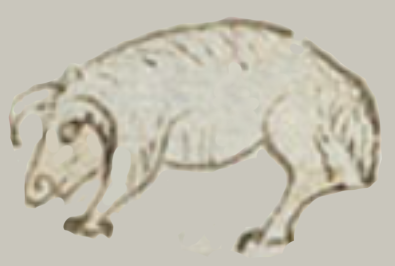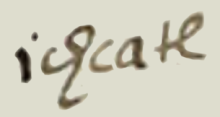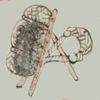ichcatl (CST34)
This painting of the simplex glyph for the term ichcatl (here, referring to sheep) shows an animal in profile facing toward the viewer’s left. On the previous page, an identical animal is referred to as a carnero (a Spanish loanword for ram). It has horns that curve downward. The rear end of the animal is cut off a little bit because the scroll that contained the scribe was overlapping with the ram. This animal represents an estancia (Spanish for a stock-raising ranch, and a loanword that entered Nahuatl) that is mentioned in the companion Nahuatl text.
Stephanie Wood
Europeans introduced stock raising to the Americas at the time of colonization. At first, these animals roamed freely, causing havoc with cornfields and doing environmental damage. Gradually, Indigenous communities got involved in the practice. Kevin Terraciano (2021) interpreted the passage about this animal to mean that Gabriel López stayed at the ranch. But the verb omotlali (tlalia in the preterit and reflexive) that refers to the estancia may be saying that it was established near this time. For example, the phrase, “omotlali Hospital,” translated as “se puso hospital,” refers to the establishment of the hospital. This one and many other examples of omotlali in our Online Nahuatl Dictionary translate it in a similar way. Also, Gabriel López may well be a brother of the shepherd Juan López who made the sale of 100 rams that is discussed on plate 33.
Stephanie Wood
1550–1564
Jeff Haskett-Wood
carneros, cuernos, crianza, ganadería, estancias, lana

ichca(tl), unspun cotton or wool, or a sheep, https://nahuatl.wired-humanities.org/content/ichcatl
carnero
Stephanie Wood
Códice Sierra-Texupan, plate 34, page dated 1560. Origin: Santa Catalina Texupan, Mixteca Alta, State of Oaxaca. Kevin Terraciano has published an outstanding study of this manuscript (Codex Sierra, 2021), and in his book he refers to alphabetic and “pictorial” writing, not hieroglyphic writing. We are still counting some of the imagery from this source as hieroglyphic writing, but we are also including examples of “iconography” where the images verge on European style illustrations or scenes showing activities. We have this iconography category so that such images can be fruitfully compared with hieroglyphs. Hieroglyphic writing was evolving as a result of the influence of European illustrations, and even alphabetic writing impacted it.
https://bidilaf.buap.mx/objeto.xql?id=48281&busqueda=Texupan&action=search
The Biblioteca Digital Lafragua of the Biblioteca Histórica José María Lafragua in Puebla, Mexico, publishes this Códice Sierra-Texupan, 1550–1564 (62pp., 30.7 x 21.8 cm.), referring to it as being in the “Public Domain.” This image is published here under a Creative Commons license, asking that you cite the Biblioteca Digital Lafragua and this Visual Lexicon of Aztec Hieroglyphs.





